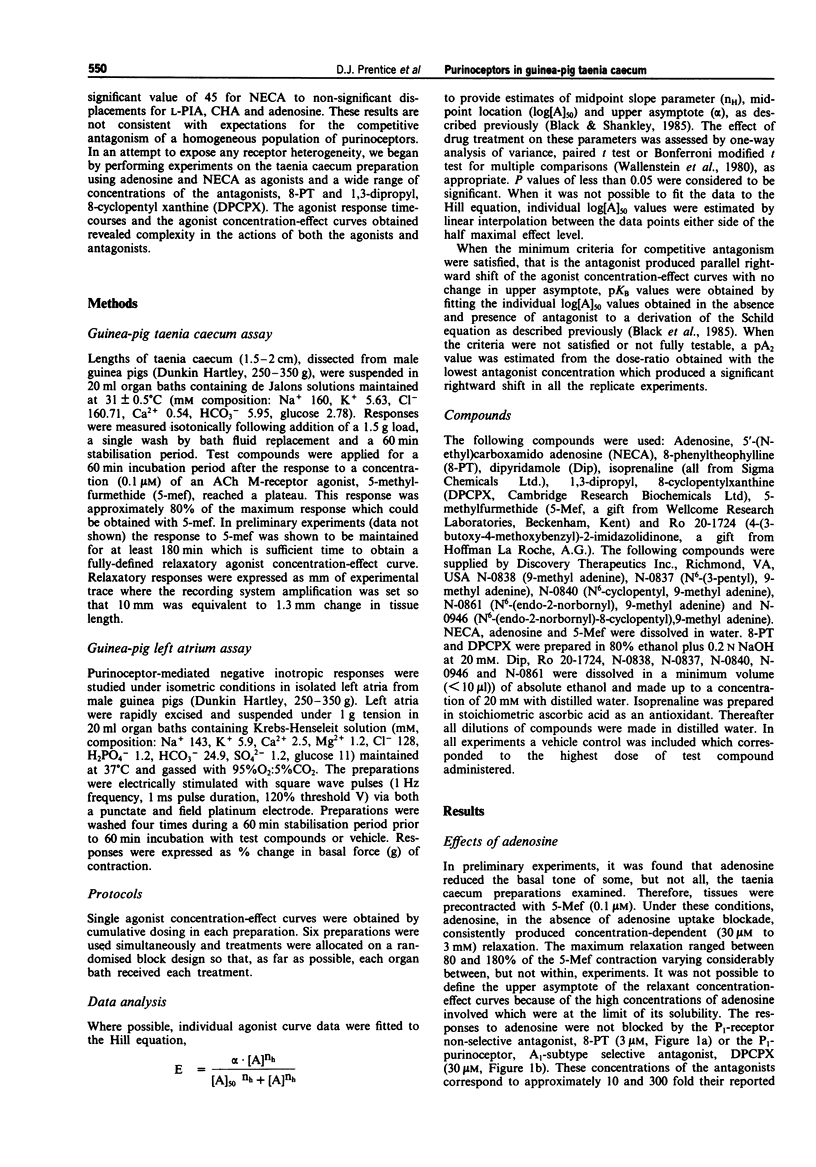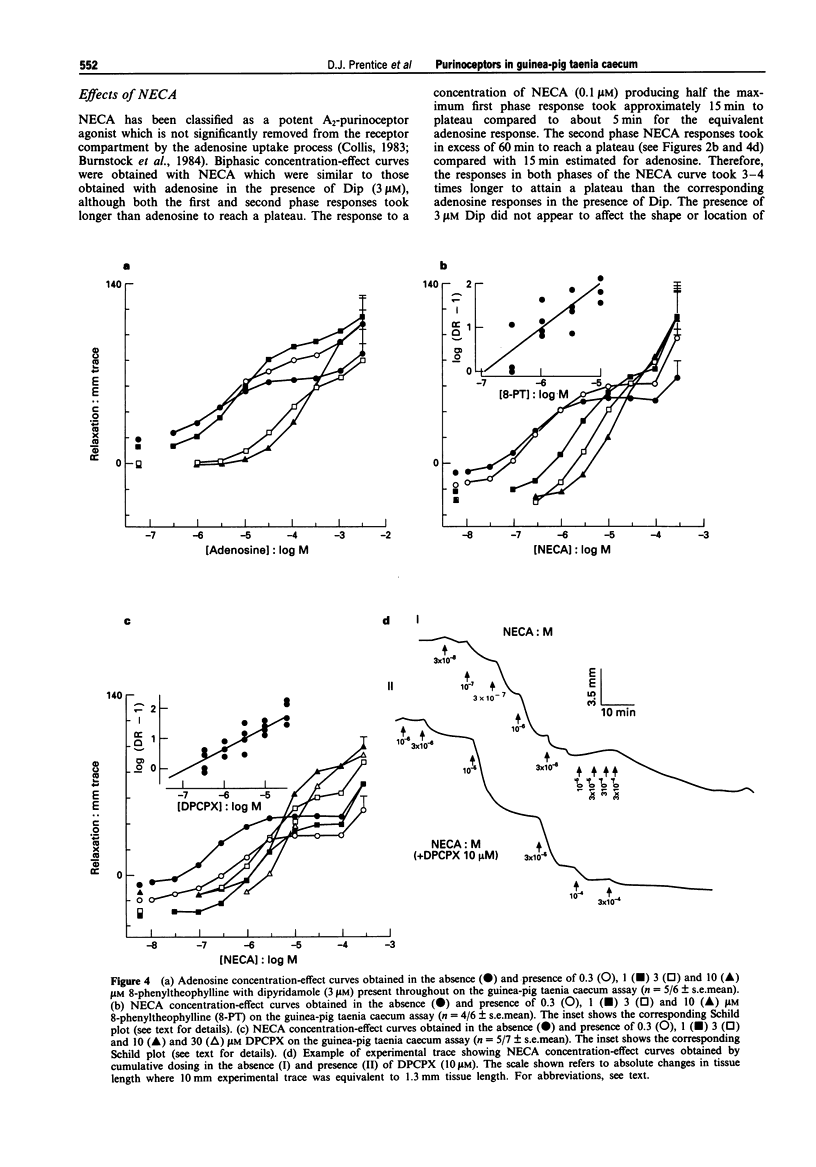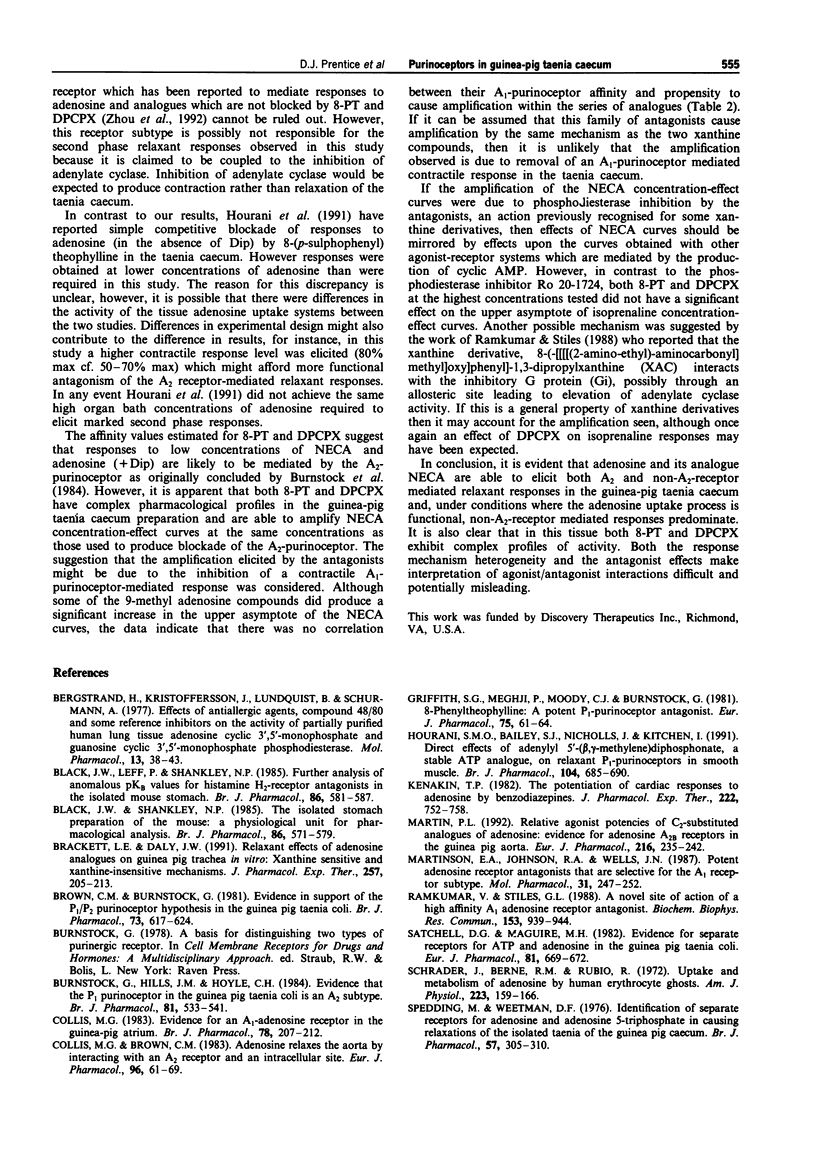Abstract
1. In the absence of adenosine uptake inhibition, adenosine produced a concentration-dependent (threshold 30 microM) relaxation of the 5-methylfurmethide pre-contracted guinea-pig taenia caecum. The relaxation was not blocked by 8-phenyltheophylline (8-PT, 3 microM) or 1,3-dipropyl, 8-cyclopentylxanthine (DPCPX, 30 microM). 2. In the presence of the adenosine uptake inhibitor, dipyridamole (Dip, 3 microM), a biphasic adenosine concentration-effect curve was obtained (threshold 0.3 microM). The time course of the responses to adenosine in the absence of Dip was similar to that of the second phase responses in the presence of Dip and occurred over the same adenosine concentration-range. 5'-(N-ethyl) carboxamido-adenosine (NECA) concentration-effect curves (in the absence of Dip) were also biphasic. Only the first phases of the concentration-effect curves obtained with NECA and adenosine (plus Dip) were inhibited by 8-PT. The pA2 values for 8-PT of 6.7 and 7.0 versus adenosine and NECA, respectively, were consistent with actions at P1-purinoceptors. There was a trend towards an increase in the upper asymptote of the first phase of the NECA curve in the presence of increasing concentrations of 8-PT. The A1-purinoceptor selective antagonist, DPCPX, also blocked only the first phase of the NECA concentration-effect curve and produced a significant increase in the upper asymptote. The pA2 value (6.8) obtained was consistent with activation of A2-subtype P1-purinoceptors by the low concentrations of NECA.(ABSTRACT TRUNCATED AT 250 WORDS)
Full text
PDF







Selected References
These references are in PubMed. This may not be the complete list of references from this article.
- Bergstrand H., Kristoffersson J., Lundquist B., Schurmann A. Effects of antiallergic agents, compound 48/80, and some reference inhibitors on the activity of partially purified human lung tissue adenosine cyclic 3',5'-monophosphate and guanosine cyclic 3',5'-monophosphate phosphodiesterases. Mol Pharmacol. 1977 Jan;13(1):38–43. [PubMed] [Google Scholar]
- Black J. W., Leff P., Shankley N. P. Further analysis of anomalous pKB values for histamine H2-receptor antagonists on the mouse isolated stomach assay. Br J Pharmacol. 1985 Nov;86(3):581–587. doi: 10.1111/j.1476-5381.1985.tb08934.x. [DOI] [PMC free article] [PubMed] [Google Scholar]
- Black J. W., Shankley N. P. The isolated stomach preparation of the mouse: a physiological unit for pharmacological analysis. Br J Pharmacol. 1985 Nov;86(3):571–579. doi: 10.1111/j.1476-5381.1985.tb08933.x. [DOI] [PMC free article] [PubMed] [Google Scholar]
- Brackett L. E., Daly J. W. Relaxant effects of adenosine analogs on guinea pig trachea in vitro: xanthine-sensitive and xanthine-insensitive mechanisms. J Pharmacol Exp Ther. 1991 Apr;257(1):205–213. [PubMed] [Google Scholar]
- Brown C. M., Burnstock G. Evidence in support of the P1/P2 purinoceptor hypothesis in the guinea-pig taenia coli. Br J Pharmacol. 1981 Jul;73(3):617–624. doi: 10.1111/j.1476-5381.1981.tb16796.x. [DOI] [PMC free article] [PubMed] [Google Scholar]
- Burnstock G., Hills J. M., Hoyle C. H. Evidence that the P1-purinoceptor in the guinea-pig taenia coli is an A2-subtype. Br J Pharmacol. 1984 Mar;81(3):533–541. doi: 10.1111/j.1476-5381.1984.tb10106.x. [DOI] [PMC free article] [PubMed] [Google Scholar]
- Collis M. G., Brown C. M. Adenosine relaxes the aorta by interacting with an A2 receptor and an intracellular site. Eur J Pharmacol. 1983 Dec 9;96(1-2):61–69. doi: 10.1016/0014-2999(83)90529-0. [DOI] [PubMed] [Google Scholar]
- Collis M. G. Evidence for an A1-adenosine receptor in the guinea-pig atrium. Br J Pharmacol. 1983 Jan;78(1):207–212. doi: 10.1111/j.1476-5381.1983.tb09381.x. [DOI] [PMC free article] [PubMed] [Google Scholar]
- Griffith S. G., Meghji P., Moody C. J., Burnstock G. 8-phenyltheophylline: a potent P1-purinoceptor antagonist. Eur J Pharmacol. 1981 Oct 15;75(1):61–64. doi: 10.1016/0014-2999(81)90346-0. [DOI] [PubMed] [Google Scholar]
- Hourani S. M., Bailey S. J., Nicholls J., Kitchen I. Direct effects of adenylyl 5'-(beta,gamma-methylene)diphosphonate, a stable ATP analogue, on relaxant P1-purinoceptors in smooth muscle. Br J Pharmacol. 1991 Nov;104(3):685–690. doi: 10.1111/j.1476-5381.1991.tb12489.x. [DOI] [PMC free article] [PubMed] [Google Scholar]
- Kenakin T. P. The potentiation of cardiac responses to adenosine by benzodiazepines. J Pharmacol Exp Ther. 1982 Sep;222(3):752–758. [PubMed] [Google Scholar]
- Martin P. L. Relative agonist potencies of C2-substituted analogues of adenosine: evidence for adenosine A2B receptors in the guinea pig aorta. Eur J Pharmacol. 1992 Jun 5;216(2):235–242. doi: 10.1016/0014-2999(92)90365-b. [DOI] [PubMed] [Google Scholar]
- Martinson E. A., Johnson R. A., Wells J. N. Potent adenosine receptor antagonists that are selective for the A1 receptor subtype. Mol Pharmacol. 1987 Mar;31(3):247–252. [PubMed] [Google Scholar]
- Ramkumar V., Stiles G. L. A novel site of action of a high affinity A1 adenosine receptor antagonist. Biochem Biophys Res Commun. 1988 Jun 30;153(3):939–944. doi: 10.1016/s0006-291x(88)81318-4. [DOI] [PubMed] [Google Scholar]
- Satchell D. G., Maguire M. H. Evidence for separate receptors for ATP and adenosine in the guinea-pig taenia coli. Eur J Pharmacol. 1982 Jul 30;81(4):669–672. doi: 10.1016/0014-2999(82)90358-2. [DOI] [PubMed] [Google Scholar]
- Schrader J., Berne R. M., Rubio R. Uptake and metabolism of adenosine by human erythrocyte ghosts. Am J Physiol. 1972 Jul;223(1):159–166. doi: 10.1152/ajplegacy.1972.223.1.159. [DOI] [PubMed] [Google Scholar]
- Spedding M., Weetman D. F. Identification of separate receptors for adenosine and adenosine 5'-triphosphate in causing relaxations of the isolated taenia of the guinea-pig caecum. Br J Pharmacol. 1976 Jun;57(2):305–310. doi: 10.1111/j.1476-5381.1976.tb07480.x. [DOI] [PMC free article] [PubMed] [Google Scholar]
- Wallenstein S., Zucker C. L., Fleiss J. L. Some statistical methods useful in circulation research. Circ Res. 1980 Jul;47(1):1–9. doi: 10.1161/01.res.47.1.1. [DOI] [PubMed] [Google Scholar]
- Zhou Q. Y., Li C., Olah M. E., Johnson R. A., Stiles G. L., Civelli O. Molecular cloning and characterization of an adenosine receptor: the A3 adenosine receptor. Proc Natl Acad Sci U S A. 1992 Aug 15;89(16):7432–7436. doi: 10.1073/pnas.89.16.7432. [DOI] [PMC free article] [PubMed] [Google Scholar]
- van Calker D., Müller M., Hamprecht B. Adenosine regulates via two different types of receptors, the accumulation of cyclic AMP in cultured brain cells. J Neurochem. 1979 Nov;33(5):999–1005. doi: 10.1111/j.1471-4159.1979.tb05236.x. [DOI] [PubMed] [Google Scholar]


